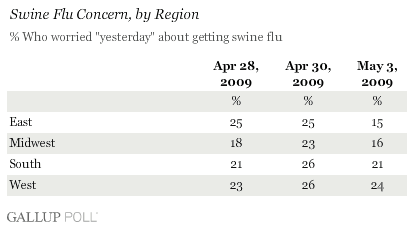PRINCETON, NJ -- A Ë┼├█┤ź├ŻPoll conducted Sunday, May 3 finds 19% of Americans saying they personally worried "yesterday" about getting swine flu, . The poll also shows no increase in the percentages of Americans taking precautionary steps to avoid getting the illness, of which more than 200 cases, but only one fatality, have been confirmed in the United States.

One in 20 Americans say they refrained from using mass transit "yesterday" out of concern about swine flu. A similar proportion opted not to go shopping or to a restaurant; however, only 1% compensated for this by shopping online or by phone -- suggesting the flu could be having a slightly negative impact on retail activity nationwide.
Five percent of parents say they kept a child home from school "yesterday"; given that the latest round of interviewing was conducted on Sunday, this response from parents was most likely an indication of their actions late last week. The least common reactions are staying home from work and canceling or postponing a scheduled airplane trip, as well as shopping online in lieu of going to a store.
Since last week, concern over swine flu, now being termed the H1N1 flu by health authorities, seems to have abated mostly in the East and Midwest, where the percentages worried have dropped from the mid-20s on Thursday to the mid-teens on Sunday. The rate of concern remains above 20% in both the South and the West, little different than was found last week.

The current regional ranking on this measure does not entirely match the concentration of swine flu cases nationwide, as the East has produced the highest number of cases of any region, and the Midwest the lowest.
As of Sunday morning, as Ë┼├█┤ź├Żinterviewing for the current survey began, the Centers for Disease Control were reporting 226 confirmed cases of the H1N1 flu. The highest number of cases in that report was in the East, with 91; however, most of these were concentrated in New York state, which reported 63 cases. Sixty-four cases were confirmed in the South, including 40 in Texas. Fifty-one cases were confirmed in the West, with most occurring in California and Arizona. Only 20 cases were confirmed throughout the Midwest.
Young adults continue to express greater concern than seniors, as do parents of children under 18 compared to those with no minors at home.

Outbreaks of swine flu are reportedly slowing in Mexico, where most schools and non-essential businesses have been temporarily closed, and the public's use of face masks has become commonplace. At the same time, the World Health Organization is closely monitoring the spread of the flu to other countries, and has warned it could soon issue its highest level of pandemic alert if the infected numbers grow in Europe or Asia.
Ë┼├█┤ź├Żwill continue to monitor U.S. consumer reaction to swine flu in the coming week as events warrant.
Survey Methods
Results are based on telephone interviews with 1,011 national adults, aged 18 and older, conducted May 3, 2009, as part of Ë┼├█┤ź├ŻPoll Daily tracking. For results based on the total sample of national adults, one can say with 95% confidence that the maximum margin of sampling error is ┬▒3 percentage points.
Interviews are conducted with respondents on land-line telephones (for respondents with a land-line telephone) and cellular phones (for respondents who are cell-phone only).
In addition to sampling error, question wording and practical difficulties in conducting surveys can introduce error or bias into the findings of public opinion polls.
Polls conducted entirely in one day, such as this one, are subject to additional error or bias not found in polls conducted over several days.
